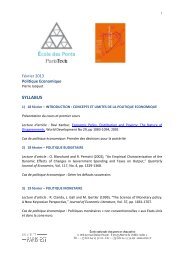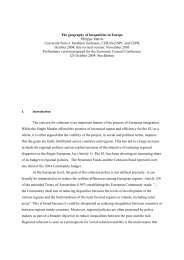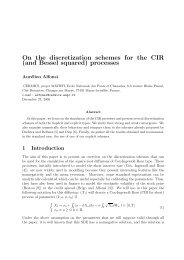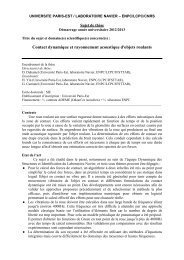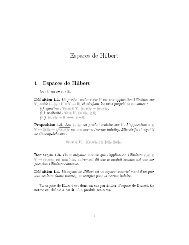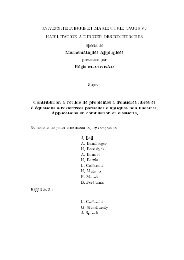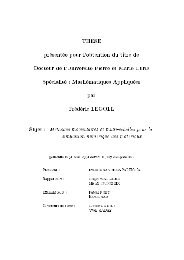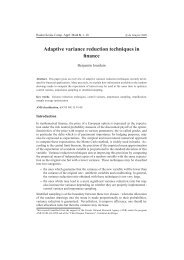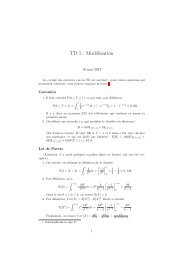Create successful ePaper yourself
Turn your PDF publications into a flip-book with our unique Google optimized e-Paper software.
20 Chapitre 2 : Analyse numérique dans un cas simplié<br />
Theorem 2.1.1 If the global minimizers of (2.1) are all nondegenerate, then for any<br />
starting guess suciently close to the solution set, there exists a subsequence of the<br />
iterates of the decomposition algorithm of Figure 2.1 which approaches a stationary<br />
point for (2.1).<br />
Remark 1. In the special case where H 1 = H 2 and ɛ 3 − ɛ 2 ≥ ɛ 2 − ɛ 1 , it is shown<br />
in [6] that the decomposition algorithm is globally convergent for any starting point.<br />
On the other, we observe in Section 2.5 that when ɛ 3 −ɛ 2 < ɛ 2 −ɛ 1 , then for specially<br />
chosen starting points, the algorithm could converge to a stationary point which is<br />
not a global minimum.<br />
In our local convergence result Theorem 2.1.1, the requirement for the starting<br />
point ensures that the iterates avoid degenerate points for either H 1 or H 2 . <strong>Le</strong>t<br />
C d denote the minimum value for the objective function of (2.1) subject to the<br />
additional constraint that either x 1 is degenerate for H 2 or x 2 is degenerate for H 1 .<br />
Since the global minimizers of (2.1) are nondegenerate, C d is strictly larger than the<br />
minimum value for the objective function. If the objective function at the starting<br />
point is strictly less than C d , then the iterates are bounded away from degenerate<br />
points for either H 1 or H 2 .<br />
The paper is organized as follows. In Section 2.2 we develop necessary and sucient<br />
optimality conditions for a quadratic optimization problem with both a sphere<br />
and an ane constraint, and we develop necessary optimality conditions for (2.1).<br />
In Section 2.3 we apply the optimality theory to obtain an optimal solution for the<br />
local subproblem, and we show that the multipliers in the subproblems possess a<br />
continuity property. The optimality theory also yields the solution to the original<br />
problem (2.1) when H 1 and H 2 commute. In Section 2.4 we prove our local convergence<br />
result Theorem 2.1.1. In Section 2.5 we investigate the global convergence of<br />
the decomposition algorithm using a series of numerical examples.<br />
2.2 Optimality Conditions<br />
Each step of the domain decomposition algorithm requires the solution of a<br />
sphere constrained, quadratic programming problem with a linear constraint. This<br />
leads us to consider a problem with the structure<br />
min f(x) := 1 2 xT Hx − h T x subject to x T x = 1, Ax = b, (2.12)<br />
where A is m by n, h ∈ R n , and b ∈ R m . The local steps of our decomposition<br />
algorithm correspond to the case h = 0, m = 1, and b = 0. Our analysis in this<br />
section, however, applies to the more general quadratic cost function and linear<br />
constraints appearing in (2.12).<br />
The following result gives necessary and sucient conditions for a point to be<br />
a global minimum. Without the linear constraint, this result is known (see [110]).<br />
We give a slightly dierent analysis which also takes into account linear constraints.



